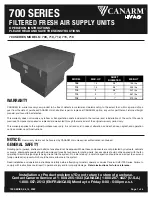
14
The Three Methods of Installation
The three methods of installation for the HRV/ERV system are:
• The Simplified installation.
• The Partially Dedicated Installation
• The Fully Dedicated Installation
Simplified Installations
The Simplified Installation draws stale air from the cold air return
duct of the air handler/furnace and introduces an equal amount of
fresh air farther downstream into the cold air return. Refer to
"Simplified Installation Diagrams".
The air handler/furnace blower must be running when the unit is
operating for this system to be effective. Refer to
"Interlocking the
HRV/ERV to an Air handler/Furnace Blower".
Partially Dedicated Installations
The Partially Dedicated Installation draws stale air from specific
points in the house and introduces an equal amount of fresh air into
the cold air return. Refer to
"Partially Dedicated Installation
Diagrams".
Stale air ducts should be installed in areas of the home where the
poorest indoor air quality exists (bathrooms and kitchen). Each
location with a stale air duct should have a timer to initiate high
speed ventilation. Refer to "
Optional Timers
" in this manual.
The air handler/furnace blower should be running when the
HRV/ERV is operating to evenly distribute the fresh air
throughout the house. Refer to
"Interlocking the HRV/ERV to an
Air handler/Furnace Blower"
.
Fully Dedicated Installations
The Fully Dedicated Installation draws stale air from specific
points in the house and delivers fresh air to specific locations of the
house. This system is not connected to an air handler/furnace.
Refer to "
The Fully Dedicated Installation Diagrams
" in this
manual.
Stale air ducts should be installed in areas of the home where the
poorest indoor air quality exists (bathrooms and kitchen). Each
location with a stale air duct should have a timer which will initiate
high speed ventilation. Refer to "Optional Timers" in this manual.
Fresh air ducts should be installed to all bedrooms and living areas,
excluding bathrooms, kitchen and utility areas. Grilles should be
located high on a wall or in ceiling locations. Grilles that diffuse
the air comfortably are recommended. Refer to "Grilles" in this
manual. Special care should be taken in locating grilles if the floor
is the only option available. Areas such as under baseboard heaters
will help to temper the air.
Installing the Ducting Between the HRV/ERV &
Living Areas in the House
A well designed and installed ducting system will allow the
HRV/ERV to operate at its maximum efficiency.
All ducts should be kept short and have as few bends or elbows as
possible to maximize airflow. Forty-five degree elbows are
preferred to 90° elbows. Use "Y" tees instead of straight tees
whenever possible.
All duct joints must be fastened with screws, rivets or duct sealant
and wrapped with mastic or quality duct tape to prevent leakage.
Mastic is preferred but if duct tape is used, we recommend
aluminum foil duct tape.
Galvanized (rigid) ducting from the HRV/ERV to the living areas
in the house is recommended whenever possible although flexible
duct can be used in moderation if necessary.
A short length (approximately 12 inches or 300mm) of non-
metallic flexible insulated duct should be connected between the
HRV/ERV and the supply/exhaust duct system to avoid possible
noise transfer through the duct system.
All ducts running through attics and unheated spaces must be
sealed and insulated to code.
Installation Methods
Applications such as greenhouses, atriums,
swimming pools, saunas, etc. have unique
ventilation requirements which should be
addressed with an isolated ventilation system.
Summary of Contents for Heat Recovery Ventilator HRV 120SRD
Page 35: ......















































